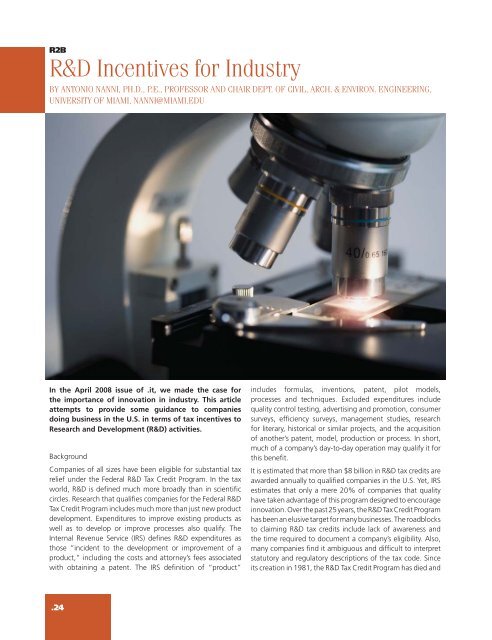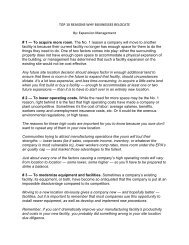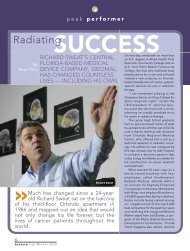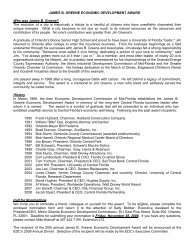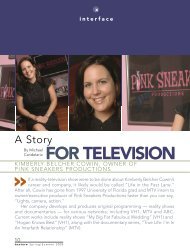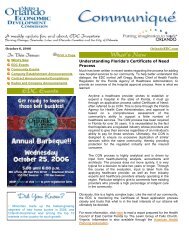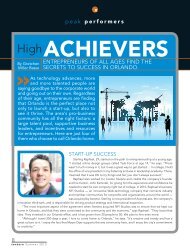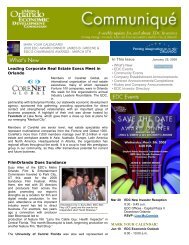R2BR&D Incentives f<strong>or</strong> IndustryBY ANTONIO NANNI, PH.D., P.E., PROFESSOR AND CHAIR DEPT. OF CIVIL, ARCH. & ENVIRON. ENGINEERING,UNIVERSITY OF MIAMI, NANNI@MIAMI.EDUIn the April 2008 <strong>is</strong>sue of .<strong>it</strong>, we made the case f<strong>or</strong>the imp<strong>or</strong>tance of innovation in industry. Th<strong>is</strong> articleattempts to provide some guidance to companiesdoing <strong>business</strong> in the U.S. in terms of tax incentives toResearch and Development (R&D) activ<strong>it</strong>ies.BackgroundCompanies of all sizes have been eligible f<strong>or</strong> substantial taxrelief under the Federal R&D Tax Cred<strong>it</strong> Program. In the taxw<strong>or</strong>ld, R&D <strong>is</strong> defined much m<strong>or</strong>e broadly than in scientificcircles. Research that qualifies companies f<strong>or</strong> the Federal R&DTax Cred<strong>it</strong> Program includes much m<strong>or</strong>e than just new productdevelopment. Expend<strong>it</strong>ures to improve ex<strong>is</strong>ting products aswell as to develop <strong>or</strong> improve processes also qualify. TheInternal Revenue Service (IRS) defines R&D expend<strong>it</strong>ures asthose “incident to the development <strong>or</strong> improvement of aproduct,” including the costs and att<strong>or</strong>ney’s fees associatedw<strong>it</strong>h obtaining a patent. The IRS defin<strong>it</strong>ion of “product”includes f<strong>or</strong>mulas, inventions, patent, pilot models,processes and techniques. Excluded expend<strong>it</strong>ures includequal<strong>it</strong>y control testing, advert<strong>is</strong>ing and promotion, consumersurveys, efficiency surveys, management studies, researchf<strong>or</strong> l<strong>it</strong>erary, h<strong>is</strong>t<strong>or</strong>ical <strong>or</strong> similar projects, and the acqu<strong>is</strong><strong>it</strong>ionof another’s patent, model, production <strong>or</strong> process. In sh<strong>or</strong>t,much of a company’s day-to-day operation may qualify <strong>it</strong> f<strong>or</strong>th<strong>is</strong> benef<strong>it</strong>.It <strong>is</strong> estimated that m<strong>or</strong>e than $8 billion in R&D tax cred<strong>it</strong>s areawarded annually to qualified companies in the U.S. Yet, IRSestimates that only a mere 20% of companies that qual<strong>it</strong>yhave taken advantage of th<strong>is</strong> program designed to encourageinnovation. Over the past 25 years, the R&D Tax Cred<strong>it</strong> Programhas been an elusive target f<strong>or</strong> many <strong>business</strong>es. The roadblocksto claiming R&D tax cred<strong>it</strong>s include lack of awareness andthe time required to document a company’s eligibil<strong>it</strong>y. Also,many companies find <strong>it</strong> ambiguous and difficult to interpretstatut<strong>or</strong>y and regulat<strong>or</strong>y descriptions of the tax code. Since<strong>it</strong>s creation in 1981, the R&D Tax Cred<strong>it</strong> Program has died and.24
has been resurrected at least 11 times by Congress, but never made permanent.Table 1 shows a snapshot of the s<strong>it</strong>uation as of today (see TABLE 1).Private industry expend<strong>it</strong>ures R&D have increased to about two-thirds of nationalR&D spending, as the government’s p<strong>or</strong>tion has declined, from 1.92 percent ofGDP in 1964 to 0.80 percent of GDP in 2004. While R&D <strong>is</strong> often considered thedomain of large companies, smaller <strong>business</strong>es have m<strong>or</strong>e to gain, as the value ofthe R&D cred<strong>it</strong> as a percentage of their assets can be as high as 9.4 percent. Of the16,000 <strong>business</strong>es using the R&D cred<strong>it</strong>, m<strong>or</strong>e than 4,500 companies have assetsof less than $1 million.Businesses must first determine their base amount of R&D expense. The <strong>business</strong>can claim 20 percent of R&D expenses over that base amount, which will varyfrom <strong>business</strong> to <strong>business</strong>. The w<strong>or</strong>k must be done in the U.S. f<strong>or</strong> U.S. researchand development. Businesses may be able to go back as far as three years inclaiming the R&D cred<strong>it</strong>. Utilizing the R&D tax cred<strong>it</strong> can result in “found money”f<strong>or</strong> <strong>business</strong>es, allowing investment in further research and development <strong>or</strong> other<strong>business</strong> growth activ<strong>it</strong>ies.Finally, tax incentives to promote R&D are also provided at the state level w<strong>it</strong>htheir myriad variations across states as, f<strong>or</strong> example, a nonrefundable tax cred<strong>it</strong>against the c<strong>or</strong>p<strong>or</strong>ate franch<strong>is</strong>e tax designed to encourage c<strong>or</strong>p<strong>or</strong>ations to invest inincreased research and development activ<strong>it</strong>ies. In general, many states model theircred<strong>it</strong>s on the federal cred<strong>it</strong>.2008 Leg<strong>is</strong>lative UpdateThe R&D tax cred<strong>it</strong> expired December 31, 2007 f<strong>or</strong> the 13th time. On April 17,Società di tutte le dimensioni hanno avuto lapossibil<strong>it</strong>à di avvalersi degli sgravi f<strong>is</strong>cali del “FederalR&D Tax Cred<strong>it</strong> Program”. Nella finanza, l’attiv<strong>it</strong>à diR&S è defin<strong>it</strong>a in modo molto più ampio di quantolo sia nei circoli scientifici. Le attiv<strong>it</strong>à di ricerca chepermettono alle società di utilizzare il “Federal R&DTax Cred<strong>it</strong> Program” includono molto di più del solosviluppo di nuovi prodotti. Le spese sostenute permigli<strong>or</strong>are prodotti es<strong>is</strong>tenti così come per sviluppareo migli<strong>or</strong>are dei processi ricadono nelle attiv<strong>it</strong>à diR&S prev<strong>is</strong>te dal programma. L’IRS (Internal RevenueService) defin<strong>is</strong>ce spese come quei “casi di sviluppoo migli<strong>or</strong>amento di un prodotto”, inclusi i costi e lecomm<strong>is</strong>sioni associate all’ottenimento di un brevetto.La definizione dell’IRS di “prodotto” include f<strong>or</strong>mule,invenzioni, brevetti, prototipi, processi e tecniche.Sono invece escluse quelle spese relative a test peril controllo della qual<strong>it</strong>à, pubblic<strong>it</strong>à e promozionedel prodotto, sondaggi tra i consumat<strong>or</strong>i, indagin<strong>is</strong>ull’efficienza, studi sulla gestione, ricerca letteraria,st<strong>or</strong>ica o di progetti simili, e l’acqu<strong>is</strong>izione di altruibrevetto, modello industriale, produzione o processo.In breve, molte delle attiv<strong>it</strong>à quotidiane dell’impresapotrebbero essere idonee per ottenere gli incentivi.Si stima che negli Stati Un<strong>it</strong>i siano concessi ogni annocirca $8 miliardi di incentivi per finanziare l’attiv<strong>it</strong>àdi R&S di società qualificate. Ciononostante, l’IRSstima che solo il 20% delle società qualificabili haeffettivamente usufru<strong>it</strong>o del programma nato perinc<strong>or</strong>aggiare l’innovazione. Negli ultimi 25 anni, ilprogramma “R&D Tax Cred<strong>it</strong>” è stato un obiettivoincerto per molte imprese. I principali ostacoli alric<strong>or</strong>so al programma di R&S sono stati la scarsadiffusione del programma stesso ed i tempi lunghiper produrre la documentazione necessaria perla richiesta dei benefici. Inoltre, molte compagnietrovano di difficile ed ambigua comprensione len<strong>or</strong>me ed i regolamenti della leg<strong>is</strong>lazione f<strong>is</strong>cale.Fin dalla sua nasc<strong>it</strong>a nel 1981, il “R&D Tax Cred<strong>it</strong>Program” è m<strong>or</strong>to e r<strong>is</strong><strong>or</strong>to almeno 11 volte ad operadel Congresso, ma mai reso permanente.TABLE 1: U.S. FEDERAL R&D TAX CREDIT PROGRAMAllows a maximum 10% incrementalcred<strong>it</strong> (a nominal 20% cred<strong>it</strong>) f<strong>or</strong>qualified R&D expend<strong>it</strong>ures in excessof a calculated base amount.The Alternative Simplified Cred<strong>it</strong> (ASC)provides companies w<strong>it</strong>h a cred<strong>it</strong> of12% of R&D expend<strong>it</strong>ures that exceed50% of average R&D expend<strong>it</strong>uresover the pri<strong>or</strong> three years.An Alternative Incremental ResearchCred<strong>it</strong> (AIRC) f<strong>or</strong>mula <strong>is</strong> also available.The AIRC computation combines athree tiered fixed-base percentagew<strong>it</strong>h a reduced three-tiered cred<strong>it</strong>percentage.The <strong>business</strong> deduction f<strong>or</strong> R&Dexpenses must be reduced by theamount of any R&D cred<strong>it</strong>.Consente di ricevere fino al 10%di cred<strong>it</strong>o aggiuntivo (per un val<strong>or</strong>enominale non superi<strong>or</strong>e al 20%)per spese giustificate di R&S ineccesso r<strong>is</strong>petto all’ammontare basestabil<strong>it</strong>o.L’ASC (Alternative Simplified Cred<strong>it</strong>)riconosce alle imprese un cred<strong>it</strong>opari al 12% sulle spese di R&S chesuperino del 50% la media dellespese in R&S reg<strong>is</strong>trate negli ultim<strong>it</strong>re anni.L’AIRC (Alternative IncrementalResearch Cred<strong>it</strong>) é un ulteri<strong>or</strong>emeccan<strong>is</strong>mo che combina 3scaglioni di percentuali su base f<strong>is</strong>sacon tre scaglioni di percentuale dicred<strong>it</strong>o ridotto.Gli sgravi ricevuti per le spese in R&Sdevono essere dedotti dal val<strong>or</strong>e deicred<strong>it</strong>i relativi alla stessaThe U.S. R&D Tax Cred<strong>it</strong>Program expired onDecember 31, 2007.In 2006, Congressenacted into law aseamless extension ofthe R&D tax cred<strong>it</strong> fromJanuary 1, 2006, throughDecember 31, 2007.Included in the law waslanguage to strengthenthe cred<strong>it</strong> w<strong>it</strong>h a newcred<strong>it</strong> f<strong>or</strong>mula called theAlternative SimplifiedCred<strong>it</strong> that becameeffective January 1, 2007through December 31,2007.Il “U.S. Tax Cred<strong>it</strong>Program” è scaduto il31 Dicembre 2007. Nel2006 il congresso legiferòuna pr<strong>or</strong>oga del “R&Dtax cred<strong>it</strong>” valida dal1 gennaio 2006 al 31dicembre 2007.Tale legge prevedevainoltre un raff<strong>or</strong>zamentodel meccan<strong>is</strong>mo dielargizione del cred<strong>it</strong>oattraverso l’utilizzo diuna nuova f<strong>or</strong>mulache prende il nome di“Alternative SimplifiedCred<strong>it</strong>”, il nuovo metodoè entrato in vig<strong>or</strong>e apartire dal 1 gennaio2007 fino al 31 dicembre2007..25


